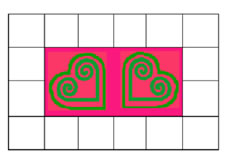
1. If you have an ABC pattern, how many tiles (at least) should you show so that children can figure out and be confident they know what the pattern is?
2. Which of these questions are appropriate for kindergarten children, when asked about an ABC pattern where 9 tiles are shown and the next 6 are hidden (and the visible and hidden tiles are numbered)?
a. What comes next in the pattern?
b. What are the next 5 tiles in the pattern?
c. What is the 14th tile?
d. What is the 20th tile?
e. What is the 100th tile?
3. Write a 3rd grade question or problem about the pattern described in #2 that suggests a skip counting strategy.

4. Write a problem or set of problems that use the multiplicative nature of this pattern.
5. Write an easier and a harder set of problems that use the ratio relationships between different kinds of pattern blocks.
6. Write a question about possible houses that relies on an understanding of how the number of square pattern blocks corresponds to the number of houses.
The following questions refer to the pattern block fish pattern:

7. In what way is this pattern more complicated to understand than the houses pattern above?
8. Write a problem or set of problems to help children analyze and understand the pattern of the growing fish.
9. Write a problem or set of problems to help children gather and organize information about the fish pattern.
10. Write a problem or set of problems asking children to make 3rd grade appropriate predictions about the growing fish pattern.

11. Which of these patterns (there may be more than one) will make a completed pattern for this border?
a. rb b. rrb c. rrbb d. rrbbb
Explain how you know.
12. What is the longest border pattern you could make that would be complete in this border, and that would show the pattern at least twice on the border mat?
13. The pattern ABCABC is exactly the same pattern (will look exactly the same) as:
a. ABBABB b. ABC c. ABCA d. ABCAB e. CABCAB
14. Fill in the blanks to make the sentences correct:
a. ____ is a factor of ____ (15, 3)
b. ____ is a multiple of ______ (36, 4)
c. ____ is divisible by _______ (27, 9)
d. ____ can be evenly divided by ____ (42, 6)
e. ____ divides evenly into ___ (7, 56)